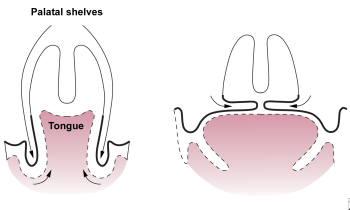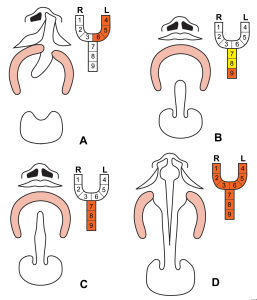Various classification schemes have been devised in the last 70 years for cleft
lip and palate, but few have received widespread clinical acceptance. Four of the
more accepted schemes are highlighted below.
Davis and Ritchie Classification
The Davis and Ritchie classification divides cleft lip and palate into 2 groups,
which subdivided into the extent of the cleft as follows:
-
Group I - Clefts anterior to the alveolus (unilateral, median, or bilateral cleft
lip)
-
Group II - Postalveolar clefts (cleft palate alone, soft palate alone, soft palate
and hard palate, or submucous cleft)
Veau Classification
The Veau classification system divides the cleft lip and palate into 4 groups, which
are as follows and illustrated in the image below:
- Group I – Defects of the soft palate only
- Group II – Defects involving the hard palate and soft palate
-
Group III – Defects involving the soft palate to the alveolus, usually involving
the lip
-
Group IV – Complete bilateral clefts Veau classification of cleft lip and palate.
A: Group I. Defects of the soft palate only. B: Group II. Defects involving the
hard palate and soft palate. C: Group III. Defects involving the soft palate to
the alveolus, usually involving the lip. D: Group IV. Complete bilateral clefts.
Kernahan and Stark Symbolic Classification
The Kernahan and Stark classification highlights the anatomic and embryonic importance
of the incisive foramen that is formed during weeks 4-7 gestational age (GA). The
secondary palate forms the roof of the mouth from the incisive foramen to the uvula
during weeks 7-12 GA (see the image below).
This system provides a graphic classification scheme using a Y- configuration, which
can be divided into 9 areas, as follows (see also the image below) :
- Areas 1 and 4 – Lip
- Areas 2 and 5 – Alveolus
- Areas 3 and 6 – Palate between the alveolus and the incisive foramen
- Areas 7 and 8 – Hard palate
-
Area 9 – Soft palate Kernahan and Stark symbolic classification of cleft lip and
palate. R = right; L = left.
International Confederation of Plastic and Reconstructive Surgery classification
The International Confederation of Plastic and Reconstructive Surgery classification
system uses an embryonic framework to divide clefts into 3 groups, with further
subdivisions to denote unilateral or bilateral cases, as follows:
- Group I – Defects of the lip or alveolus
- Group II – Clefts of the secondary palate (hard palate, soft palate, or both)
- Group III – Any combination of clefts involving the primary and secondary palates
Koul introduced a method for documenting all types of cleft lip and cleft palate
for data storage and communication.[3] This "Expression System" incorporates the
actual words for the anatomical structures affected by clefts and can describe accurately
and easily, without the need for consulting reference materials, the location and
extent of both typical and atypical clefts. The Expression System overcomes several
limitations of previous cleft registration methods, and its simplicity and precision
benefits all those involved in the care of patients with cleft lip/palate by furthering
the interdisciplinary and intradisciplinary approach.






